Although major retailers, like Amazon and Wal-Mart, have extensive drone offerings, the uptake of this new technology into amateur radio has been somewhat slow. The objective of this article is to review some of the basics, perhaps overcome some ham radio community reluctance to drone adoption and do some “blue skying” for what’s a very cool technology. Ham radio towers could be a thing of the past…
Drones to Take Towers – The Basics
The most important initial ham radio application of drones is in putting antenna supports impossibly high in trees without putting a human at risk. There are several ways to approach this problem, but I’ve used three basic approaches to testing drone antenna lift.
- The simplest is to obtain a simple, low-cost drone. Secure a very light paracord line to the drone with a zip-tie. Launch and steer over the desired obstacle and land on the far side. The limitations here come down to the weight of the paracord and local “flying conditions.”
- The longer-range, higher-lift approach is to use a lighter (but very strong) twisted fishing line (“spider wire”) pre-loaded on a spinning reel. The light line is attached to the drone, again with a light zip tie. The drone is launched over the obstacle. But, then on the far side, the “spider wire” is used to back haul a heavier line. Typically 500 pound paracord which can be purchased online at reasonable cost for 1,000 foot rolls.
- There is some risk with “spider wire” though in that the line may not always remain below the drone, especially in a light breeze. To reduce this flight risk, a ½ ounce fishing weight on a 3-foot “leader” can be used to reduce the risk of line-prop interference problems.
When using any of these techniques, it is important to fly to and over the intended antenna support and then well beyond (by a distance of obstacle height) in order to keep the lifting line clear of props.
This approach makes it possible for a single operator to field a very high (tree top level) antenna with three supports in about a half-hour’s time, depending on brush and local terrain.
With these basics, it’s clear that antenna launchers, of which I’ve got several (sling shot, arrows, compressed air powered “sinkers” and others) most pale in comparison to drone performance.
Limitations on Radio Antenna Drones?
There are some operating issues to be understood before first using drone antenna launch systems.
The first is weather. Drones are rated as to the amount of wind, especially cross winds, that they can tolerate. Typically, when deploying antennas in light breezes, the real problem is less the wind than the lightweight line being blown off the objective by cross winds.
The second constraint is temperature. Because thin air is less “flight friendly” you may notice a decrease in drone lifting capacity on a hot day compared with a coolish winter deployment.
The third is time. While modern drones are typically capable of flight in the 20–30-minute class for the under 0.55 pounds (or less than 250 grams) for unlicensed drones, time will shrink as payload increases.
Regulations Matter
Most hams will likely use an “off the shelf, unlicensed drone” for antenna lifts. It makes the most sense. Recreational use, inside Class G airspace (under 400 feet and not in an airport boundary on an FAA sectional chart). The drone can become one of the most valuable tools in your antenna deployment kit.
However, in big 72-point bold font, put in your memory “Do not fly inside five miles from any airport and no higher than 400 feet – nowhere no matter what.”
The FAA has an online certification program for licensing drone pilots. It’s called a Part 107 UAV license. Because a lot of fixed wing pilots were interested, the FAA also offers a Part 61 (fixed wing) Pilot transition course which may be used to shorten the process. With well over 1,000 hours in the left seat, I used this course and picked up my UAV license with about two hours of study.
There are recurrent training requirements as well, so plan on a few hours every two years keeping sharp if you want to maintain “currency” as a licensed (commercial use) drone pilot.
Additionally, these light UAVs must be operated under the following conditions:
- Subsection 44809. Exception for limited recreational operations of unmanned aircraft
(a) In General.-Except as provided in subsection (e), and notwithstanding chapter 447 of title 49, United States Code, a person may operate a small unmanned aircraft without specific certification or operating authority from the Federal Aviation Administration if the operation adheres to all of the following limitations:
(1) The aircraft is flown strictly for recreational purposes.
(2) The aircraft is operated in accordance with or within the programming of a community-based organization’s set of safety guidelines that are developed in coordination with the Federal Aviation Administration.
(3) The aircraft is flown within the visual line of sight of the person operating the aircraft or a visual observer co-located and in direct communication with the operator.
(4) The aircraft is operated in a manner that does not interfere with and gives way to any manned aircraft.
(5) In Class B, Class C, or Class D airspace or within the lateral boundaries of the surface area of Class E airspace designated for an airport, the operator obtains prior authorization from the Administrator or designee before operating and complies with all airspace restrictions and prohibitions.
(6) In Class G airspace, the aircraft is flown from the surface to not more than 400 feet above ground level and complies with all airspace restrictions and prohibitions.
(7) The operator has passed an aeronautical knowledge and safety test described in subsection (g) and maintains proof of test passage to be made available to the Administrator or law enforcement upon request.
(8) The aircraft is registered and marked in accordance with chapter 441 of this title and proof of registration is made available to the Administrator or a designee of the Administrator or law enforcement upon request.
Again, the secret to happy ham use of drones comes down to:
- Under 250-gram UAV.
- 5 miles+ away from airports, fly under 400 feet.
- No flight over people
And please don’t try to put antennas over power lines! Ham radio is supposed to be a hobby for smart people.
Drone Maintenance
There will be times when using “spider wire” that something will go wrong. I had a drone tense up on the lifting line when the reel snagged. As the drone tilted to add lift to the “stuck side” it lost GPS lock and flew sideways into the side of the house. Oops!
Drone repairs, while in the DIY column, are not terribly difficult. Putting on a new strut/motor assembly to replace a broken one is much easier (if you are older) using that SMT magnifying LED microscope!
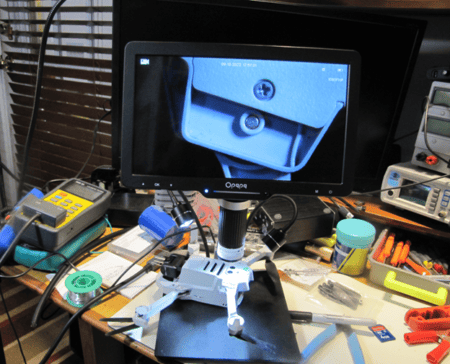
Once back together, off to lift more antennas.
Blue Sky Antennas
Now that we have access to “the sky” let’s go through some of the possibilities for antennas. We will lay out some important engineering and design concepts in this and subsequent reports.
The first step is to experiment with a simple vertical antenna. For this, we can test to see how much weight a drone can lift. Typically, 200-500 grams for the 250-gram unlicensed class, or from 0.35 pound to just over 1 pound.
Unfortunately, there is no free lunch. The heavier the antenna, the less time “at altitude” you will be able to persist.
For low band (80 meter) use, an 85-foot non-resonant vertical operated against a good ground would be a useful starting point.
The problem? Over the soil conductivity in this part of East Texas, this is not really a high-performance test bed. We know that 85-feet of wire is going to weigh something. The question is what size wire will our drone be “happy with?”
We know, for example, that as wire gets smaller it becomes less useful for antennas. Wire smaller than #22, for example, is not as good as #14. The engineering trade-off is that #18 bare copper wire (16 strand) is about the limit for our drone at 85 feet, coming in around 0.4182 pound (189.7 grams).
A little time in the antenna modeler, though, tells us that the non-resonant wire isn’t as good a choice as a quarter wave wire of 66-feet. And, because it is lighter, the drone will be able to “sky hook” it for a bit longer.
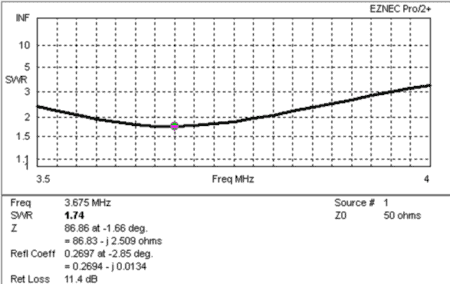
As with all low-frequency antennas, this would have a very low take-off angle (something HOA dwellers can only dream about) but remember that the practical limit is how close to building a perfect ground (modeled here) you can build under that well-manicured lawn the HOAs worship:
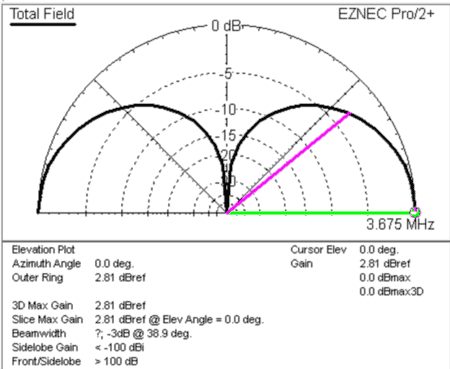
Still, looks encouraging.
And here in Eas Texas, such an antenna would do acceptably well in a reasonably low take-off angle over basic moderate ground conductivity dirt:
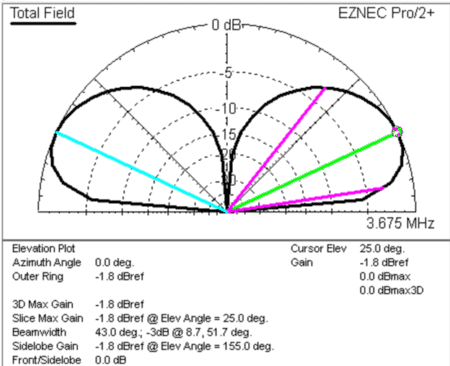
Although the small gain turns into a loss when modeled as a MININEC ground (as opposed to High Accuracy) ground model, when we add-back modeling losses (-4.75 dB) the net-out is 2.95 dB which means an OK signal.
Facing the Persistence Problem
While this first pass through a drone lifted antenna isn’t any great shakes yet, we’re now able to focus on two things that really matter. Persistence and multiple element arrays.
The persistence problem is that while the ¼ wave drone will work, it will need a battery change about every 10-minutes, or so.
Fortunately, this is solvable by removing the battery from the drone. In its place, we can run (very lightweight) power lines up to the drone. Equal in weight to the battery removed from the aircraft.
This is not a particularly reliable thing, from the operational standpoint, but if we up our power game and run aircraft power via an (alarmed) uninterruptible power supply, now we have something to talk about.
This antenna now has high persistence in light to moderate wind conditions. If could even stay aloft almost indefinitely. While also keeping a video camera online for property surveillance from this “high perch.”
Adding Additional Elements
We can now begin to envision ham radio drone lifted antenna arrays becoming a commercially viable product line.
What we would do (marketer hat on now) is to say that Drone Ham Antennas would be typed by number of antenna “support points” available.
Such systems would be designed, from the ground up (so to speak) as an expandable system.
You would begin with the Type 1 kit (one attach point, ground powered and tethered) with a quarter wave vertical on your choice of 80 meters or 160 meters.
The Type 2 kit, two attach points and power/tethers would enable you to put up a dramatic Marconi or Zepp type antenna. Whose performance using a 135-foot horizontal element from 66 feet up our to the second drone would blow the socks of most ground-based antennas.
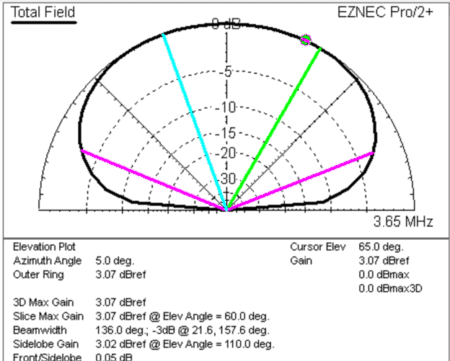
From here, we can envision a Type 3 (attach points) antenna. For this, an additional ½ wave section to make a steerable array. Which at the 180-degree setting would offer a conventional dipole result in models. But which develops lobes when the drones are repositioned.
In other words, Stage 1 is a single drone, but as we add to the lifting drones, a whole world of steerable arrays comes into focus. A simple 80-meter Type 4 (four-corner loop) delivers 10 dB over a dipole, right down at the radio horizon (10 degrees) at 66-foot tethering levels, for example when operated on the 20-meter ham band:
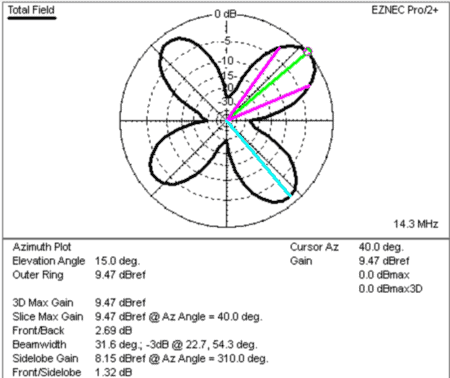
Additionally, because the drones are all concurrently steerable, you can put this signal on any point of the compass desired. Which in turn, allows controlled changes to the antenna pattern. Say, in order to increase signal into Europe from my home in East Texas, I would draw in the sides of the horizontal loop, for example:
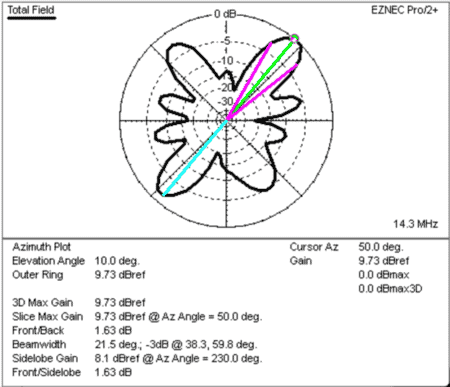
Integrating this with a multiple drone steerable controller is not a trivial task. But the key thing is it’s doable.
And this means we can begin to think about radical new and relatively low-cost options in ham radio antenna deployment.
Move this array up to 150 feet? More engineering, but we’ll get into that in Part 2 next week.
Meanwhile? I’ve contacted several companies that are in the military drone space already because I think there’s an important (breakthrough) commercial product here.
Cost-Benefit Breakthrough
Already, commercially available fishing drones operating with up to 8-pound loads are available. Not cheap, but out there.
I think it’s only a matter of time until someone (besides us) begins looking at the potential game-changer opportunity at hand.
Conventional ham radio antennas are cost-limited in the height of antenna used. But it’s axiomatic on the radio engineering end (though not the financial side) that there is no such thing as “too high” for an antenna. Price is another matter.
Compared to a Type 4 tethered drone, the comparable performance from a towered antenna is remarkably more complex.
I recently priced an 89-foot crank up tower to replace the 60-foot crank up tower here. The basic tower was $21,000 plus another (roughly) $1,000 in delivery charges. Call that $22,000.
A tower also means dirt work, steel rebar work, and concrete plus a base unit. Toss in another $5,000 for these. Then we will need the rotator ($1,500) and the antenna ($1,800) plus control cables for the rotator ($300). In all, the cost of a basic tower at the 90-foot level? $30,600 – and that’s before hiring the labor to put it all together, assemble and test. Likely another $6,000.
On top of this – if you don’t live under a Homeowner Association where such things are dead on the vine from the get-go – you would also have permits, inspections, and approvals. Toss in a zoning variance in most of the blue states and many of the red, on top. Which means counsel and money, too.
The tethered drone approach we advocate is considerably cheaper. For low power operators, you can “get by” with a two drone (Type 2) 120-foot tethered drone solution. Which could be configured either as the L (Marconi) or Zepp type. Where the two-wire feedline of the Zepp could carry power to the drone, as well.
Next week, we’ll get into the second (admittedly harder) part of this project: Figuring out all the underlying engineering and seeing if we can really build it!
Write when you get rich,
George@Ure.net

“I recently priced an 89-foot crank up tower to replace the 60-foot crank up tower here. The basic tower was $21,000 plus another (roughly) $1,000 in delivery charges. Call that $22,000.”
The City of Carmel, Indiana sold a 384′ tower last year, for $100…
No. No. ., and oh hell, NO ! With the internet down and communication systems, especially cell phones not working, the last thing I want is a drone tethered to my house, 200 feet up for all to see and hone-in on. Placing a target on my house is not in the survival cards.
Around my neck of the woods drones are not very welcomed. I took one out two Summers ago with my cross bow as it hovered around in a neighbor’s back yard. The cross-bow bolt stuck in a tree [ still there ] and the drone spun sideways and crashed into a field of rocks – lots of nice little pieces. [ don’t know if they ever found it.] That is a real no – no around here.
With hordes of desperate people that will do just about any and everything for a peanut butter sandwich and a glass of powdered milk., having a bat signal directly over my house, that is basically saying – come on over – this is where the party is.., is not gonna fly around here.
Innovative and kind of cool.., however, maybe you should consider – Just because I can doesn’t mean I should.
A 100-watt transmitter maps to about 2 RF Amperes, well within the current capability of even 20 guge wire. Black plastic-coated wire and a smallish black balloon, on a non-breezy night should word usefully.
For that matter, a quarter wave long black wire run from your window, run low and horiontally, to a tree will work way better that you might think. You would want an antenna tuner for bet results.
High performance loops of about a meter or two in diameter can work VERY well for both receive and transmit. 100-watt capable transmit loops ARE available and d\DO work, but they’re still a bit pricy. They’ll drop in a little while as competition kicks in.
For now, put up ANYthing; but put up SOMEthing while the sun still shines.
I believe time may be short. Old vacuum tube receivers are dirt cheap and are somewhat EMP resistant by nature. (AM broadcast and shortwave is da bomb.)
Hallicrafters SX62 is a super-fine example. Looks cool, too.
https://www.rigpix.com/hallicrafters/sx62.htm
or,
https://www.rigpix.com/hallicrafters/s108.htm
73
“I think it’s only a matter of time until someone (besides us) begins looking at the potential game-changer opportunity at hand.”
I been thinking about that all morning. I was thinking about that before i came on your page today to see we are on the same page.
What are the rules on a tethered balloon holding up wire as an antenna ?
250 grams wouldn’t allow for a miniature solar radio-controlled zeppelin, with enough lift to pick up a wire.
I can see where this will result in a discussion with someone in FAA flight standards. because yes, 250 doesn’t have much carry capacity (thougdh a 250 g mavic will lift another 200-250 gm. And there’s the weight savings on a tethered device (no battery)
w2orst case, I really am a part 107 licensee (along with fixed wing).
The a/c weight discussion will be interesting. Because the gross takeoff weight of the a/c is under 250 gms, but as it pulls up payload (the electric line feed of #22… well, it should be an interesting call. I will be well under the regulator 250gm MGTOW and it wqill be purely recreational, I mean given ham band conditions and all…
VEry, very interesting…
So, what kind of license do you have to have to fly one of these bad boys in the outdoors ?:
https://www.rc-zeppelin.com/
As far as I know, a tethered flying machine or balloon/blimp is not regulated by the FAA. I could be wrong, but it might get around some regulations regarding size, etc. I’d also read that an airplane was not regulated when within ground effect. It’s been a while and regulations may have changed.
Obviously, any tethering needs to take CG/CL into account.
Radio controlled!
“An ex-Nazi mad scientist uses radio-controlled atomic-powered zombies in his quest to help an exiled American gangster return to power.”
https://www.imdb.com/video/vi2069085721/?playlistId=tt0047960&ref_=tt_pr_ov_vi
Easy answer. EMP events — either man-made, or natural — come in degrees of severity. Distance is deterministic. If you’re too close you’re zzapped.
Ham radio equipment can also be stored in shielded boxes, or metal cans like garbge cans, and brought out after the shooting stops. (Assuming the EMP is a single-wave one-time incident, and is not repeated at intervals.) Clearly, some unpredictability is likely.
Excellent points – and we will get more into the design aspects of a drone-lifted system for ham radio use in next weeks artiucle.
But do take a look at the low voltage 1500 w bidirectional TVS (*transient voltage suppressors) in the product https://www.vishay.com/docs/88303/15smc.pdf which weigh less than 0.22 gm each at https://www.vishay.com/docs/88303/15smc.pdf
Pretty sure with awareness in the initial design phase both at source and load, emp becomes a non-issue.
For the power sources? maybe a different story. But even with a tower the power source and a working transmitter would be satill problematic post emp
Would ham radios be included in the (see below) “no communications”?
“Count on Nuclear War in conjunction with economic collapse, starvation, and no communications; so, make your plans accordingly.” – G.A. STEWART
https://theageofdesolation.com/nostradamus/2024/01/20/the-fake-world-part-i/
Wow dude. Bravo! Bravo! Lots and lots of good stuff.
I have never been to your page. Very cool. I am inpressed. And im not impressed by many.
I agree about the 2024 election. 100%
And i agree about trump.
Good stuff.
Hams have a saying: “When all else fails, Ham Radio works!”
Maybe no ‘mass communications’ everyone relies on. But hams are independent minded and practice going out ‘in the field’ with emergancy power or solar and emergency antennas. Somewhere, somehow, there will be hams ‘on the air’.
Planet X;
Twitter renamed “X”;
Announced by WEF; Disease “X”.
Do you think all of that is a coincidence?
Does “X” mark the spot?
https://www.naturalnews.com/2024-01-22-congress-legislation-disease-x-act-bioweapon-pandemic.html
https://articles.mercola.com/sites/articles/archive/2024/01/23/disease-x.aspx?ui=9dceb5042daf6ecb116b27a569767141e4ca44e5f73b5d1d97c4514d2596ae27&sd=20151030&cid_source=dnl&cid_medium=email&cid_content=art1HL&cid=20231219&foDate=true&mid=DM1505856&rid=1996317163
https://thepeoplesvoice.tv/barack-obama-orders-govts-to-prepare-public-for-imminent-depopulation-event/
Robert Bauval – The Master Game:
https://www.youtube.com/watch?v=YzYLbaUt40E
Agreed: You can now start to see the chess pieces put in play to remove all impediments to Trump’s return as President only to be used like a cudgel to destroy; can’t have what’s left of the American citizen really realize a rise again scenario; it is just not going to be allowed.
This decline has been planned, it’s not coincidence, it’s not a bunch of people messing things up from one end to the other, it’s CONTROLLED DEMOLITION.
It’s a PULL IT, by the same ole people that have been pulling the strings for a very very long time.
This is the CONQUEST; this is the CAPSTONE of the Pyramid; the Pinnacle of Success.
More Excellent Planning:
The Great Taking Documentary – well worth your time, it is a TRUE education of how we are where we are in the global roll up the scroll situation.
https://www.youtube.com/watch?v=dk3AVceraTI
The link to the free pdf book:
https://thegreattaking.com/read-online-or-download
Good conversation on what to do:
https://www.realjewnews.com/?p=1803
ALERT: NATO ADMIRAL TELLS TRUTH “STOCKPILE FOOD AND PREPARE FOR ALL OUT NUCLEAR WAR”
https://www.youtube.com/watch?v=mMDg4T0s2Ho
And, lastly Henry Makow- he is raw.
2nd story: Jan 23 – Prediction: Trump Will Lead US Into WW3